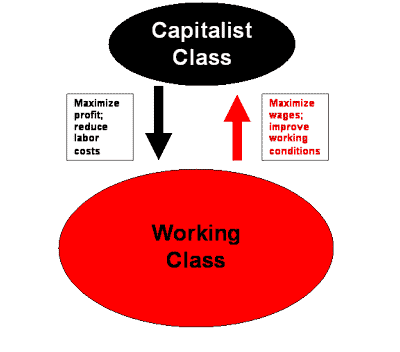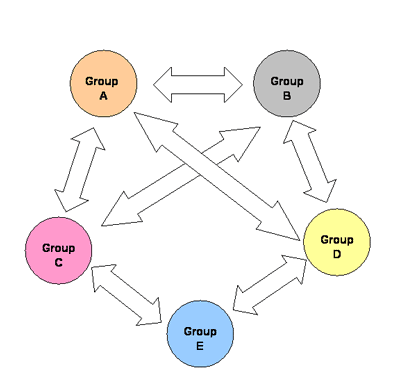
Theories of Deviant Drinking4. Macro-Relativistic: Conflict Theory |
Sociologists, political scientists, and historians have long been interested in how conflict between different groups or segments of society influences the law and other societal definitions of deviance in the United States. In general, these macro-relativistic theorists view the political arena as a battleground where different economic classes or competing interest groups struggle to control who or what gets defined and punished as "deviant." To understand some important differences between the theories falling within the conflict tradition, it is helpful to distinguish between neo-Marxist and interest group versions of conflict theory.
 |
|
Neo-Marxist
Model of Class Conflict |
Neo-Marxist theories of class conflict, which are based on the ideas of Karl Marx, have been primarily responsible for the argument that law and social control in the U.S. reflect and protect the interests of a powerful elite class. Marx, himself, did not develop a systematic theory of deviance or crime, but contemporary neo-Marxists have attempted to extend his view that the legal and political systems of capitalist societies are products of an underlying, historical process of conflict between opposing economic classes. Briefly, neo-Marxists point out that the interests of the dominant capitalist class--to maintain control of the economic system, to maximize profit, and to minimize the cost of labor--inherently conflict with the interests of the workers. On the other hand, the interests of the workers--to maximize the returns of their labor, to improve working conditions, and to gain greater control of the productive process--threaten the dominance of the ruling capitalist class. Therefore, neo-Marxist theories focus particular attention on the economic structure of society and on the relationship of societal definitions of deviance to the process of class conflict. Activities that threaten the interests of the capitalist class, such as labor union organizing or efforts to tax profits from tobacco or alcohol sales, will be defined as illegal or deviant. Neo-Marxists view class inequality and economic conflict as the fundamental sources of social problems and definitions of deviance in all advanced capitalist societies.
Theories of interest group conflict, on the other hand, tend to be based on the pluralistic assumption that all modem societies contain a number of groups with conflicting or competing interests and values. Working with a more diversified conception of the political process than the neo-Marxists, interest group theorists contend that changes in the law or in systems of social control may be generated by conflicts between various cultural, religious, or ethnic groups as well as by conflict between groups with divergent economic interests. In general, interest group theorists fit more in the mold of conventional scientific investigators and manifest less concern with social criticism and political activism than do the neo-Marxists.
Research on interest group conflict has made some significant contributions to our understanding of how racial and ethnic conflict has shaped American policies toward certain drugs. Early laws against opium in California were aimed at Chinese immigrants. Hostility toward African Americans played an important role in legislation dealing with cocaine. The crusade against marijuana in the 1930s was partially fueled by antipathy toward Mexican immigrants--a crusade that has left its mark on contemporary definitions of marijuana use as deviance. However, no historical case of interest group conflict in the U.S. was more consequential or more widespread than the "symbolic crusade" against alcohol during the Prohibition Movement.
 |
|
Pluralistic
Model of Interest Group Conflict
|
In American society, no body of law is so exalted and so final as is the Constitution of the United States. In January 1919, the following statement was formally added to this body of law as part of the 18th Amendment:
After one year from the ratification of this article the manufacture, sale or transportation of intoxicating liquors within, the importation thereof into, or the exportation thereof from the United States and all territory subject to the jurisdiction thereof for beverage purposes is hereby prohibited.
In short, the distribution and sale of alcoholic beverages was constitutionally defined as deviant. The Prohibition Amendment, focusing as it does on the rather mundane question of alcohol use, today seems curiously out of place in a legal document concerned with such fundamental issues as human rights and the basic structure of American government. How and why was this remarkable definition of deviance created?
Gusfield attempts to answer this question in Symbolic Crusade (1963), a relativistic analysis of the Temperance or Prohibition movement that climaxed with the passage of the 18th Amendment. According to Gusfield, the driving force behind the Temperance movement was cultural conflict between rural, Protestant, native Americans, and a newer population in the United States around the turn of the century—urban, Catholic immigrants from Europe. The parties to this conflict were not sharply divided by class distinctions, i.e., by the ownership and nonownership of property. Far from being an economic elite, the native Americans who supported the Temperance movement were members of the old middle class whose economic position was not too far above that of the immigrant groups they opposed. Neither were class interests or economic issues at the center of the political struggle over Prohibition. Rather, Gusfield interprets the Temperance movement as an effort of native Americans to preserve their status interests—their position as a highly prestigious and respected cultural group in American society—against the growing threat of alien cultures introduced by a vast wave of European immigrants.
Gusfield develops a theory of status politics as a framework for understanding these aspects of the Temperance movement and other “symbolic crusades” aimed at the moral reform of public policy (1963:12-35, 166-188). Gusfield points out that complex societies, in addition to being divided into various classes in an economic order, are also stratified according to a status order, in which the values, norms and lifestyles of some groups have greater prestige than do those of other groups. Prestige is symbolically conferred upon a given group when its moral viewpoint is reflected in the policies and actions of government, schools, and other societal institutions. The law is a particularly useful instrument for maintaining status dominance. A group whose cultural norms and values are backed by the authority of the law can command the respect or, at least, the obedience of other groups. Thus, moral issues, such as Prohibition, civil liberties, or abortion, are the arena of status politics, where conflicting cultural groups struggle for public recognition and legal endorsement of their respective ways of life. The ultimate goal of status politics is clear: “Victory in issues of status is the symbolic conferral of respect upon the norms of the victor and disrespect upon the norms of the vanquished” (1963: 174).
Gusfield applies this theoretical framework in a historical analysis of the development of the Temperance movement based on documents and records of various Temperance organizations. He found that reformers in the early and middle 1800s viewed drinkers as repentant deviants who could be encouraged to change their errant ways through moral persuasion. Although drunkenness was an offense against the value placed on sobriety and hard work by rural, middle-class Americans, neither drinkers nor their behavior posed a significant threat to the dominance of that group in the status order of small-town American society.
However, this situation changed
markedly toward the end of the 19th century. A massive influx of European immigrants
swelled the populations of major cities in the
According to Gusfield, the political issue of Prohibition became symbolic of the struggle between immigrant and native groups for cultural dominance in the early 20th century. Drinking was an accepted part of everyday life for many immigrants. Therefore, through the creation of laws that prohibited this practice, native Americans could publicly reassert their moral superiority over the immigrants. During this period, Temperance organizations that represented middle-class status interests defined drinkers as “enemy deviants” who must be coerced rather than persuaded to stop the use of alcohol. Consistent with Gusfield’s thesis, rural sections of the country—the stronghold of the native, middle-class culture—led the way with local and state laws banning the sale of alcohol. Not only did Temperance forces have a solid power base in rural areas but they were also far better organized for their war against demon rum than were the opponents of Prohibition. The regional strength and organizational superiority of the Temperance movement were decisive factors in its eventual success on a national level. As viewed from the context of Gusfield’s theory of status politics, the Prohibition Amendment “was the high point of the struggle to assert the public dominance of old middle-class values. It established the victory of Protestant over Catholic, rural over urban, tradition over modernity” (1963: 7).
In focusing on conflicting status interests of different cultural groups as a central element in the Temperance movement, Gusfield does not deny the possible relevance of class conflict and economic issues for understanding other historical changes in the definition of deviance. In fact, he argues that the repeal of the Prohibition Amendment during the Depression of the 1930s was precipitated by the economic demand “for increased employment and tax revenues which a reopened beer and liquor industry would bring” (1963:127). However, Gusfield contends that in American society, where class lines are not so sharply drawn as in many European societies, status interests are an especially important source of political conflicts. According to Gusfield, a purely Marxist approach fails to appreciate the significance of cultural prestige and other symbolic goals in the efforts of some groups to impose their moral definitions of deviance on other segments of American society.
| Previous Page | Next Page |